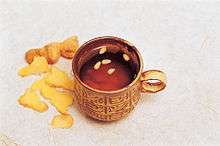Ginger tea
 A glass of ginger tea. | |
| Type | Tea |
|---|---|
| Region of origin | Asia |
| Ingredients | ginger, water |
Ginger tea is an Asian herbal-beverage that is made from ginger root. It has a long history being used as an herbal medicine in East Asia, South Asia, Southeast Asia and the Middle East.[1]
Ginger tea is usually used to prevent colds and to aid digestion, stomach upset, diarrhea, and nausea, and also as a home remedy for cough and sore throats.[2][3][4] Ginger tea was also purported to aid blood circulation.[5][6]
Variations
Ginger is native to Southeast Asia and grown in China and India since ancient times.[6][7] It is believed that ginger was introduced to Europe by Arab traders during the spice trade days.[7] Today, ginger is also grown in Central America and Africa. Ginger tea now comes out in different variations which can be served with milk, orange slices or lemon.[8][9]
Brunei, Malaysia, Singapore
In Brunei, Malaysia and Singapore cuisines, ginger tea is usually called teh halia.[10]
Indonesia
In Indonesia it is called teh jahe, although in Java, a local version of ginger tea enriched with palm sugar and spices called wedang jahe is more popular.[11]
Japan
In Japan, it is called shōgayu (生姜湯).[12]
Korea
| Korean name | |
 | |
| Hangul | 생강차 |
|---|---|
| Hanja | 生薑茶 |
| Revised Romanization | saenggangcha |
| McCune–Reischauer | saenggangch'a |
| IPA | [sɛ̝ŋ.ɡaŋ.tɕʰa] |
In Korea, ginger tea is called saenggangcha (생강차; 生薑茶). It can made either by boiling fresh ginger slices in water or mixing preserved sweetened ginger with hot water. For the latter, sliced ginger is preserved in honey. Nowadays, powdered instant versions are also widely available.[13] When served, the tea is often garnished with pine nut. Honey, sugar, or other sweetener can be added later according to taste.
Saenggangcha blended with ssukcha (mugwort tea) is called ssuksaenggangcha (mugwort ginger tea), and saenggangcha blended with daechucha (jujube tea) is called daechusaenggangcha (jujube ginger tea). Garlic or pear are also sometimes boiled with ginger.[14]
Philippines
In the Philippines, it is called salabat and served in the relatively cold month of December.[15]
See also
References
- ↑ "Ginger (Overview)". University of Maryland Medical Center. 22 June 2015. Retrieved 21 March 2016.
- ↑ "Soothing Ginger Tea". Lakeland Ledger. 19 May 1991. Retrieved 22 March 2016.
- ↑ "Flu-fighting foods can relieve symptoms". Pittsburgh Post-Gazette. 17 February 2000. Retrieved 22 March 2016.
- ↑ Henry Phillips (1827). History of cultivated vegetables: comprising their botanical, medicinal, edible, and chemical qualities; natural history; &c., &c. Henry Colburn. pp. 216–.
- ↑ "Wonder herb called ginger". New Straits Times. 3 January 1992. Retrieved 22 March 2016.
- 1 2 "Buat sendiri di rumah" (in Malay). Utusan Malaysia. 2 May 2010. Retrieved 22 March 2016.
- 1 2 Sheere Ng (9 October 2012). "Be like Ginger, the model citizen". Yahoo! News. Retrieved 22 March 2016.
- ↑ "Ginger Tea with Orange Slices". Daytona Beach Morning Journal. 29 October 1971. Retrieved 22 March 2016.
- ↑ "Lemon Ginger Tea". The Evening News. 18 May 1988. Retrieved 22 March 2016.
- ↑ "Plen-tea-ful uses". Daily Express. 11 November 2015. Retrieved 22 March 2016.
- ↑ Pepy Nasution (12 February 2010). "Wedang Jahe (Indonesian Ginger Tea)". Indonesia Eats.
- ↑ Martha Stone (23 February 2015). Japanese Cookbook: The Traditional and Simple Japanese Cuisine. Martha Stone. pp. 1–. GGKEY:H99J4YXSAAL.
- ↑ The Korea Foundation, ed. (2004). Korean Food Guide in English. Cookand / Best Home Inc. ISBN 89-89782-10-4.
437 생강차 saenggangcha – Ginger Tea / Thé au gingembre – A tea made of fresh ginger slices cooked in boiling water. Powdered instant versions are now widely available.
- ↑ "생강차 [ginger tea, 生薑茶]". Doosan Encyclopedia (in Korean). Doosan Corporation. Retrieved 23 October 2009.
- ↑ Caroline Joan Picart (January 2004). Inside Notes from the Outside. Lexington Books. pp. 48–. ISBN 978-0-7391-0763-8.
